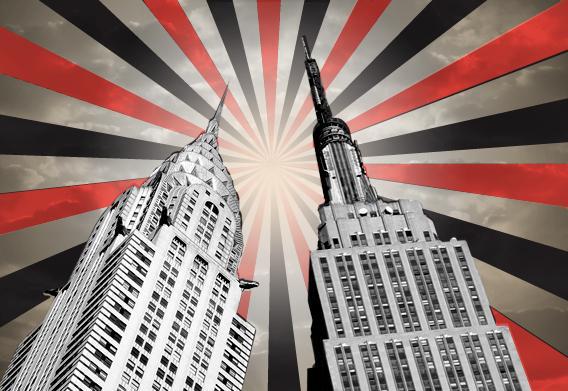Want a free trip to the top of the fourth-tallest building in the world? Locals and visitors to New York City can submit their photos of One World Trade Center to a contest for a chance to tour the unfinished building. Did I mention it’s not the sixth-, and not the fifth-, but the fourth-tallest skyscraper ever built by the hand of man?
Many will see the 2014 opening of One World Trade Center, which will rise to a symbolic 1,776-foot height, as a triumph over terrorism, fear, and despair. It will also be, inevitably, a letdown. That’s because when the design was announced in 2003, media outlets trumpeted it as the future “world’s tallest building.” Others, like the New York Times, wisely hedged, noting that it “might be the world’s tallest building upon completion.” We now know that it definitely won’t be. As planners, politicians, and architects squabbled about the design and financing for over a decade, architects in China and the Middle East built taller structures. Dubai’s Burj Khalifa now stands at 2,717 feet, a whopping 941 above One World Trade Center. The unfinished Shanghai Tower rises to 2,073 feet, and the Mecca Royal Hotel Clock Tower measures 1,971 feet.
To newly wealthy Asian nations, winning the steel-on-concrete sprint to the sky sends an important message. The designer of the Burj Khalifa said that being the tallest was “the client’s whole intention,” because “the world’s tallest building is a statement about the future of this city.”
The U.S. made no attempt to respond to the Asian skyscrapers. But we used to be made of sterner stuff! The Manhattan skyline that One World Trade Center joins is itself a monument to the American love of competition and rivalry. Once Elisha Otis invented the safety brake that freed buildings from the limitations of stairs in the mid-19th century, American magnates engaged in a decades-long rush to build the world’s tallest skyscraper. Building after building rose in American cities, each one one-upping the previous record holder.
Make no mistake about it: This was all about rivalry, ego, and superiority, not simple economics. When architect Cass Gilbert asked dime-store magnate Frank Woolworth how tall he wanted his tower to be, Woolworth didn’t mention rental space or the financially optimal height. Rather, he responded, “Make it fifty feet higher than the Metropolitan Tower.” (Metropolitan Life Insurance owned the world’s tallest building at the time, and had previously denied Woolworth a loan.)
Three architects, backed by banking and automobile tycoons, raised the stakes in the mid-1920s, staging a dramatic struggle for skyline supremacy. Two of them, William Van Alen and H. Craig Severance, had earlier been partners, but their business collapsed under the weight of their egos; the pair constantly feuded over who should have received credit for their successes. (For a great review of the Van Alen–Severance duel, pick up Neal Bascomb’s book Higher: A Historic Race to the Sky and the Making of a City.)
Walter Chrysler hired Van Alen to build the tallest building in the world, only to see his design topped mid-construction by the Manhattan Bank Company Building, designed by a Severance-led team. Not to be bested by his rival, Van Alen revised his building plans upward, only to be one-upped again. Realizing that he was locked in a potentially unending battle, Van Alen pulled a clever trick. He constructed the gorgeous Art Deco crown of the Chrysler Building inside the hollow of the unfinished structure, leading the public to believe the skyscraper had already reached its maximum height. Then, once Severance believed he had won, Van Alen dramatically extracted the top of the building from within—like a magician pulling a rabbit from his hat—to seize what surely looked like victory. Unfortunately for Van Alen and Chrysler, only a few blocks away a team of architects and rich men, led by the former New York Gov. Al Smith, were getting started on the even larger Empire State Building. (It stood as the world’s tallest building for some 40 years, until it was overtaken by the World Trade Center’s North Tower in the early 1970s.)
Did I mention that many of these events happened as the country was sliding toward financial ruin?
Like William Van Alen, the architects of One World Trade Center probably believed they were building the world’s biggest when they designed it. Likewise the creators of the original World Trade Center might have thought they had a lock on World’s Tallest Building for a while after its 1971 completion, but the Twin Towers were overtaken by Chicago’s Sears (now Willis) Tower two years later—just as the Burj Khalifa sneaked up on the Freedom Tower.
That’s why this eternal race to the top is something of a fool’s game, since it’s inevitable that something bigger will come along. But that’s the point! Records are made to be broken because people like to break records. That’s no reason to withdraw from the game. When it looked like One World Trade Center would steal the title from Taipei 101, the world’s tallest building back in 2003, Taiwanese people responded with a philosophical magnanimity worthy of a great global competition: “We know they will build taller towers elsewhere. Let’s enjoy ours while we can.”
But such fatalism is for a vanquished champion, not an also-ran. To me, the 1,776-foot height of One World Trade Center is the most problematic part of its design. Ostensibly a reference to America’s spirit of independence, the height really represents a turn inward. When Americans built ever taller buildings in the 1920s, eventually surpassing the Eiffel Tower, Europeans were too enamored of their medieval skylines to join the fray, allowing American architects to dominate the new form. When there’s a race going on, you have to try to win it. Shooting for fourth place makes no sense.
